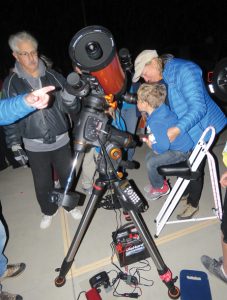 Submitted by Sue Weippert and Sara Anderson
Submitted by Sue Weippert and Sara Anderson
Poston Junior High will host its 9th annual Astronomy Night on Thursday, Nov. 21 from 6 to 8 p.m. All community members, including current and potential Poston students and their families, are invited to learn about the universe at this very fun, academically rigorous event.
Partnerships with NASA, ASU, and the East Valley Astronomy Club, as well as strong support from Poston staff and local businesses, make the hands-on activities a high-quality learning experience designed to engage the most advanced junior high school students, their preschool-aged siblings, and everyone in between.
This year NASA will again provide make-and-take soda rocket straws for the littlest of hands to learn about basic trajectory. And as in years past, the East Valley Astronomy Club will set up eight to ten large scale telescopes for guests to view various celestial objects. In addition, ASU students representing ASU’s Center for Meteorite Studies will be sharing a large collection of meteorites with visitors.
Many other perennial crowd-pleasing activities will be back for this year’s event. At the Impact Craters station, participants will drop meteors of various sizes (golf balls, marbles, etc.) on to a planet’s surface (a flour-filled pan) and measure the depth and width of the meteor’s impact to make some surprising discoveries.
Proportional understanding will come to life at the Play-Dough Planets tables. This station usually attracts lots of students, and with some help, they come to understand the shocking differences in the size of the planets.
The Leaps and Bounds station, a new activity last year, was incredibly popular. Kids tested their jumping ability here on Earth, measuring how high they could leap vertically and how far they could bound horizontally. The students then did the calculations to see how far that would translate if they had jumped on the moon or one of the other planets in the solar system.
Many volunteers are involved at the Balloon Planets station, which uses some proportional mathematics, and Poston math teachers lend a hand for those who want help calculating. Teachers are also on hand at the Measure the Universe station, where participants will learn about Kepler’s Third Law. At the Phases of the Moon station, visitors see exactly why the moon looks different to us on Earth as it proceeds through its phases.
Natalie Guest, Poston’s science department chair, is looking forward to Astronomy Night because it “unites our students, staff, families, and other community members in a night of engaging excitement.” She reports, “there’s something amazing about watching a seventh-grader explain to her younger sister how to find her favorite constellations using a star wheel, or watching an eighth-grader show his dad how far he could jump if he were on the moon.”
Last year’s Astronomy Night was attended by about 800 students and community members.
Poston administrators and event sponsors look forward to welcoming a similar crowd this year on Thursday, Nov. 21 from 6 to 8 p.m. The event is free and open to the public.

